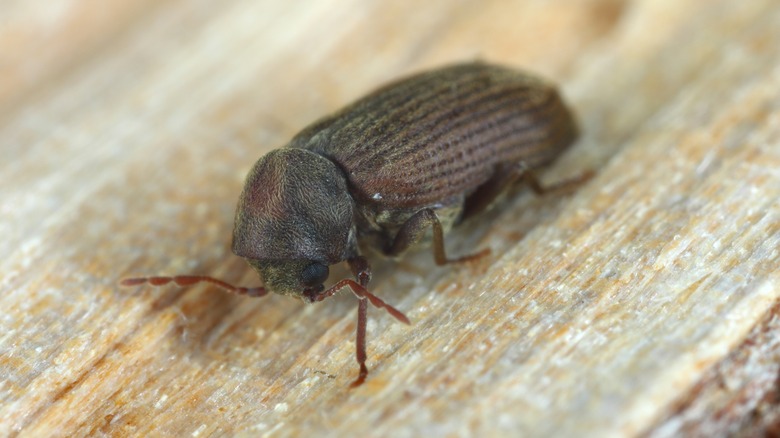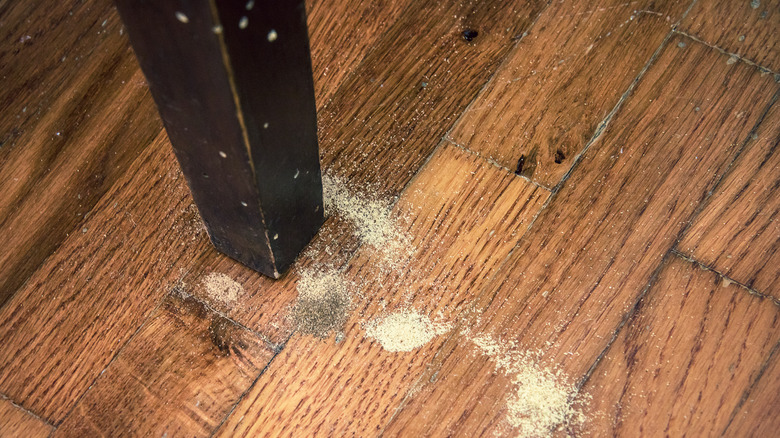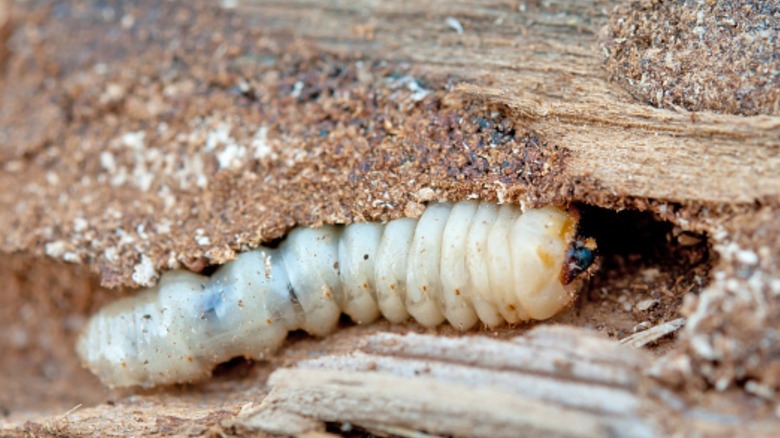The Bug That Hatches Inside Of Your Furniture (And How To Keep Them Away)
If you're thinking of thrifting or buying wood furniture from an estate sale, you might want to thoroughly inspect it first. Noticing small holes in the wood could indicate that some pesky bugs are living there, and you won't want to bring them inside your home. Common furniture beetles, also known as Anobium punctatum, produce larvae that tunnel into wood. Once inside, these larvae, referred to as woodworms, will eat the wood until they become adults in a few years.
In addition to furniture beetles, there are several other types of tiny wood-boring beetles whose larvae are also known as woodworms and can ruin wood furniture. False powderpost beetles also burrow into hardwood and softwood structures to lay their eggs. Once they hatch, the larvae will eat through the wood until they become adults. At that stage in their lives, the beetles will burrow out of the wood, leaving small holes. While false powderpost beetles lay their eggs inside the wood, powderpost and deathwatch beetles deposit their eggs on the surface of the wood. Still, when the woodworms emerge, they will make their way inside the wood and consume it.
To keep these beetles from infiltrating your home, make sure to check wooden furniture before bringing it inside, seal your furniture, and be careful when storing firewood indoors. You may need to make changes in your environment if you find you already have woodworms in your home.
How woodworms damage your furniture
The larvae of wood-boring beetles can cause some devastating damage to wooden structures over time. Depending on what type of woodworm species is eating away at your furniture, the pests could live there for up to five years, as can happen with the common furniture beetle. Not only do the woodworms eat away at your furniture or home, but they will also produce frass. As the beetle larvae consume the wood, their excrement will combine with the torn-up pieces of wood, creating frass, a material similar in appearance to sawdust. This substance may fall onto the floor under the infested furniture. One way to identify what type of wood-boring beetle is tearing up your house is by inspecting the frass. For example, powderpost beetles' frass is like a powder, while the false powderpost produces frass more like the texture of borax.
As the larvae consume the wood, they create holes and tunnels, which puts the structural integrity of your furniture in jeopardy. These young beetles may also destroy your wooden flooring, the support beams of your house, decks, or any other wood the adult beetles can find and use to safely deposit their eggs.
Preventing furniture beetles and woodworms
To keep these pests that will damage your household away, it's best to take preventative measures before they end up snacking on your furniture and more. Whenever you bring new wood into your home, whether it's furniture, pallets for a project, or firewood, take the time to look at it closely, noting if there are any tiny holes throughout the material. If you find evidence of woodworms, including frass, that piece of wood will either need to be treated for pests before you bring it inside or abandoned. Since wood-boring beetles gravitate toward dry wood, try to only keep a day's supply of firewood in your home at a time. While the furniture you already have inside might seem safe, woodworms could find their way in on another object, so it's best to treat all of your wooden furniture to protect it. Varnishes, paints, and sealants are a great way to cover any gaps or pores in the wood to keep beetles from laying their eggs.
If you already have furniture beetles and woodworms inside your home, there are ways to eliminate them. Despite preferring dry wood, these insects love humidity, so make sure you have good ventilation and consider using a dehumidifier near the insects. Additionally, you could coat the wood in permethrin (a residual insecticide) or contact a pest control agency for severe or persistent issues.



